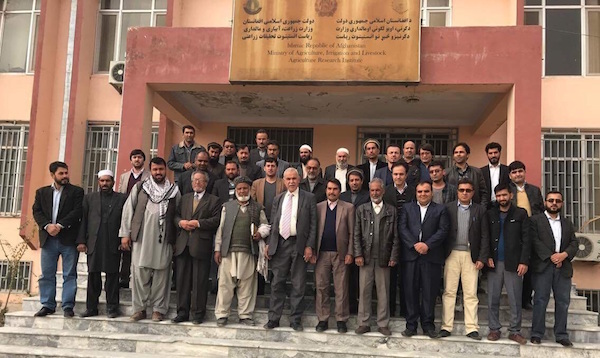
KABUL (CIMMYT) – Inadequate access to new disease-resistant varieties and short supplies of certified seed are holding back wheat output and contributing to rising food insecurity in Afghanistan, according to more than 50 national and international wheat experts.
Wheat scientists and policymakers discussed challenges to the country’s most-produced crop during a two-day meeting at Agricultural Research Institute of Afghanistan (ARIA) headquarters in Kabul, as part of the 5th Annual Wheat Researchers’ Workshop in November 2016. They took stock of constraints to the 2017 winter wheat crop, including dry autumn weather and rapidly-evolving strains of the deadly wheat disease known as yellow rust.
“Old wheat varieties are falling prey to new races of rust,” said Qudrat Soofizada, director for Adaptive Research at ARIA, pointing out that the country’s 2016 wheat harvest had remained below 5 million tons for the second year in a row, after a record harvest of more than 5.3 million tons in 2014.
The workshop was attended by 51 participants belonging to several ARIA research stations and experts from the International Maize and Wheat Improvement Center (CIMMYT), the Australian Center for International Agricultural Research (ACIAR) and World Bank’s Afghanistan Agriculture Input Project (AAIP).
Afghanistan has been importing around 2.5 million tons of cereal grain — mainly wheat — in the last two years, with most of that coming from Kazakhstan and Pakistan, according to recent reports from the Food and Agriculture Organization (FAO) of the United Nations.
“Most wheat farmers save grain from prior harvests and use that as seed, rather than sowing certified seed of newer, high-yielding and disease resistant varieties,” said Rajiv Sharma, CIMMYT senior scientist and representative at the center’s office in Afghanistan. “This is holding back the country’s wheat productivity potential.”
Sharma explained that CIMMYT has been supporting efforts of Afghanistan’s Ministry of Agriculture, Irrigation and Livestock (MAIL) to boost supplies of certified seed of improved varieties and of critical inputs like fertilizer.
“CIMMYT has worked with Afghanistan wheat scientists for decades and more than 90 percent of the country’s certified wheat varieties contain genetic contributions from our global breeding efforts,” Sharma explained.
Since 2012, the center has organised more than 1,700 wheat variety demonstrations on farmers’ fields and trained over 1,000 farmers. CIMMYT scientists are also conducting field and DNA analyses of Afghan wheats, which will allow faster and more effective breeding.
The FAO reports showed that the government, FAO and diverse non-governmental organizations had distributed some 10,000 tons of certified seed of improved wheat varieties for the current planting season. With that amount of seed farmers can sow around 67,000 hectares, but this is only some 3 percent of the country’s approximately 2.5 million-hectare wheat area.
“We have been informing the National Seed Board about older varieties that are susceptible to the rusts,” said Ghiasudin Ghanizada, head of wheat pathology at MAIL/ARIA, Kabul, adding that efforts were being made to take such varieties out of the seed supply chain.
After discussions, Ghanizada and MAIL/ARIA associates M. Hashim Azmatyar and Abdul Latif Rasekh presented the technical program for breeding, pathology and agronomy activities to end 2016 and start off 2017.
Zubair Omid, hub coordinator, CIMMYT-Afghanistan, presented results of wheat farmer field demonstrations, informing that grain yields in the demonstrations ranged from 2.8 to 7.6 tons per hectare.
T.S. Pakbin, former director of ARIA, inaugurated the meeting and highlighted CIMMYT contributions to Afghanistan’s wheat improvement work. M.Q. Obaidi, director of ARIA, thanked participants for traveling long distances to attend, despite security concerns. Nabi Hashimi, research officer, CIMMYT-Afghanistan, welcomed participants on behalf of CIMMYT and wished them good luck for the 2016-17 season.
Wheat breeding trial results were presented by Zamarai Ahmadzada from Darulaman Research Station, Kabul; Aziz Osmani from Urad Khan Research Station, Herat; Shakib Attaye from Shisham Bagh Research Station, Nangarhar; Abdul Manan from Bolan Research Station, Helmand; Said Bahram from Central Farm, Kunduz; Najibullah Jahid from Kohkaran Research Station, Kandahar; and Sarwar Aryan from Mulla Ghulam Research Station, Bamyan.
Agronomy results from the research stations of Badakhshan, Herat, Kabul, Kunduz, Helmand and Bamyan were also presented and summarized by Abdul Latif Rasikh, head of Wheat Agronomy, ARIA headquarters, Badam Bagh, Kabul
 Capacity development
Capacity development 
